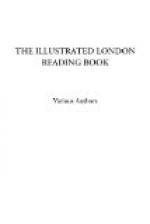Again! again! again!
And the havoc did not slack,
Till a feeble cheer the Dane
To our cheering sent us back—
Their shots along the deep
slowly boom:
Then ceased, and all is wail
As they strike the shatter’d
sail,
Or, in conflagration pale,
Light the gloom.
Out spoke the victor then,
As he hail’d them o’er
the wave,
“Ye are brothers! ye
are men!
And we conquer but to save;
So peace instead of death
let us bring.
But yield, proud foe, thy
fleet,
With their crews, at England’s
feet,
And make submission meet
To our King.”
Then Denmark bless’d
our chief,
That he gave her wounds repose;
And the sounds of joy and
grief
From her people wildly rose,
As Death withdrew his shades
from the day,
While the sun look’d
smiling bright
O’er a wide and woeful
sight,
Where the fires of funeral
light
Died away.
Now joy, old England, raise!
For the tidings of thy might,
By the festal cities’
blaze,
Whilst the wine-cup shines
in light;
And yet, amidst that joy and
uproar,
Let us think of them that
sleep,
Full many a fathom deep,
By thy wild and stormy steep—
Ellsinore!
Brave hearts! to Britain’s
pride,
Once so faithful and so true,
On the deck of fame that died
With the gallant, good Riou—
Soft sigh the winds of Heaven
o’er their grave:
While the billow mournful
rolls,
And the mermaid’s song
condoles,
Singing glory to the souls
Of the brave.
CAMPBELL.
* * * * *
ARTILLERY TACTICS.
[Illustration: Letter C.]
Cannon took their name from the French word Canne, a reed. Before their invention, machines were used for throwing enormous stones. These were imitated from the Arabs, and called ingenia, whence engineer. The first cannon were made of wood, wrapped up in numerous folds of linen, and well secured by iron hoops. The true epoch of the use of metallic cannon cannot be ascertained; it is certain, however, that they were in use about the middle of the 14th century. The Engraving beneath represents a field-battery gun taking up its position in a canter. The piece of ordnance is attached, or “limbered up” to an ammunition carriage, capable of carrying two gunners, or privates, whilst the drivers are also drilled so as to be able to serve at the gun in action, in case of casualties.
[Illustration: TAKING UP POSITION.]




